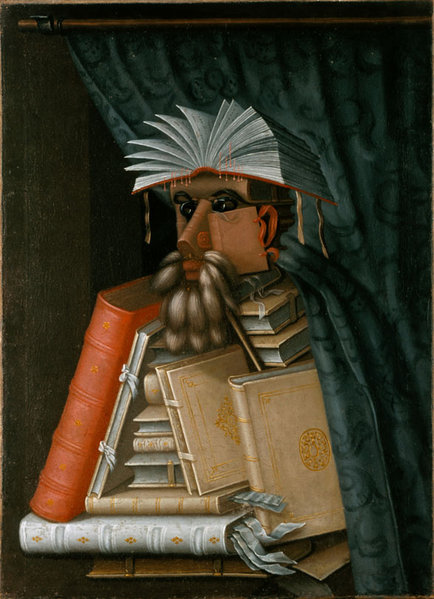Today is the anniversary of the birth of the Mannerist painter Giuseppe Arcimboldo (1527-1593), so this week’s picture is one of his ingenious “composite heads”, the so-called Librarian. The picture of a man composed entirely from books and the paraphernalia of reading, the work is traditionally said to represent Wolfgang Lazius, the librarian of Arcimboldo’s Habsburg patron, Maximilian II. Its date is uncertain but the work was probably painted some time between 1562 and 1570. It originally hung in the Kunstkammer of Maximilian, then that of his son Rudolf II, in their castle in Prague, and subsequently passed to their decsendants. Many of Arcimboldo’s works were destroyed when Prague was sacked by a Swedish army in 1648, but The Librarian survived, taken as the booty of war. It is still in Sweden today and can be seen at the museum of Skokloster Slott, near Stockholm. [Check location of SS; is it near Stockholm?]
Partly because so much of his work was lost during the sack of Prague, Arcimboldo’s reputation fell into obscurity until the twentieth century. He was rediscovered in the 1930s, when painters including Salvador Dali and museum directors such as Alfred Barr, influential founder of the Museum of Modern Art in New York, saw in his work a fascinating prefiguration of the self-consciously irrational fantasies of Surrealism. Subsequent scholarship has demonstrated, however, that Arcimboldo was anything but a proto-Surrealist, and has shown the links between his work and the often arcane symbolic cast of thought of late Renaissance humanists.
Arcimboldo’s fantasies were preeminent examples of human skill, almost outrageously clever demonstrations of the ingenuity of man designed to entertain with their extravagant wit and artifice. They spring from the same culture that enjoyed the intricate mise-en-scenes cunningly created from shells in the gardens and grottoes...


